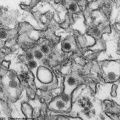File:Zika virus TEM01.jpg: Difference between revisions
(==Zika virus== Transmission electron micrograph (TEM) of virus particles are 40 nm in diameter, with an outer envelope, and an inner dense core. Zika virus (ZIKV) is a mosquito-borne ''flavivirus'' related to dengue virus first isolated from a rhes...) |
mNo edit summary |
||
| Line 4: | Line 4: | ||
Zika virus (ZIKV) is a mosquito-borne ''flavivirus'' related to dengue virus first isolated from a rhesus monkey in Zika forest, Uganda (1947). Transmitted by mosquitoes (''Aedes aegypti'') it was then identified in humans in Nigeria in 1954 and subsequently in South America, Asia and Pacific regions. More recently in Australia from returning travellers. Mosquito bites lead to an initial infection of skin cells. The virus may also be transmitted transplacentally or during delivery. Some limited evidence, from Brazil, for association with microcephaly. | Zika virus (ZIKV) is a mosquito-borne ''flavivirus'' related to dengue virus first isolated from a rhesus monkey in Zika forest, Uganda (1947). Transmitted by mosquitoes (''Aedes aegypti'') it was then identified in humans in Nigeria in 1954 and subsequently in South America, Asia and Pacific regions. More recently in Australia from returning travellers. Mosquito bites lead to an initial infection of skin cells. The virus may also be transmitted transplacentally or during delivery. Some limited evidence, from Brazil, for association with microcephaly. | ||
[[Category:Virus]][[Category:Electron micrograph]] | |||
Revision as of 10:16, 29 January 2016
Zika virus
Transmission electron micrograph (TEM) of virus particles are 40 nm in diameter, with an outer envelope, and an inner dense core.
Zika virus (ZIKV) is a mosquito-borne flavivirus related to dengue virus first isolated from a rhesus monkey in Zika forest, Uganda (1947). Transmitted by mosquitoes (Aedes aegypti) it was then identified in humans in Nigeria in 1954 and subsequently in South America, Asia and Pacific regions. More recently in Australia from returning travellers. Mosquito bites lead to an initial infection of skin cells. The virus may also be transmitted transplacentally or during delivery. Some limited evidence, from Brazil, for association with microcephaly.
File history
Yi efo/eka'e gwa ebo wo le nyangagi wuncin ye kamina wunga tinya nan
| Gwalagizhi | Nyangagi | Dimensions | User | Comment | |
|---|---|---|---|---|---|
| current | 10:15, 29 January 2016 |  | 800 × 800 (212 KB) | Z8600021 (talk | contribs) | ==Zika virus== Transmission electron micrograph (TEM) of virus particles are 40 nm in diameter, with an outer envelope, and an inner dense core. Zika virus (ZIKV) is a mosquito-borne ''flavivirus'' related to dengue virus first isolated from a rhes... |
You cannot overwrite this file.
File usage
The following page uses this file: